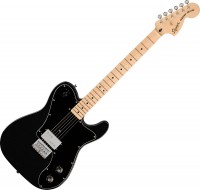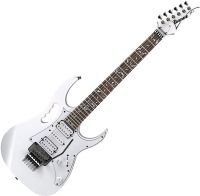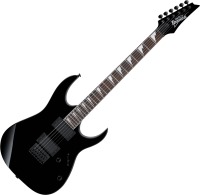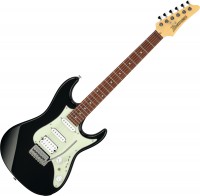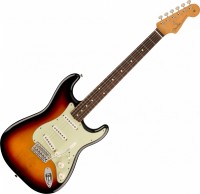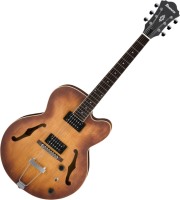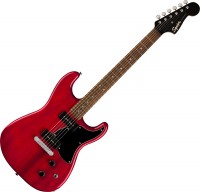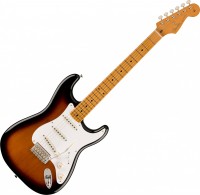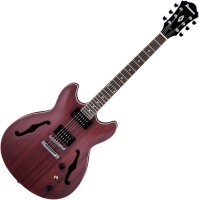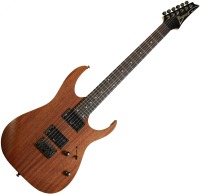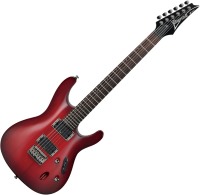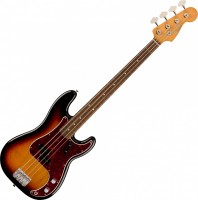Electric & Bass Guitars Epiphone
All models Advanced filters → |
You might be interested in
Electric & Bass Guitars: specifications, types
Show all
Type
— Electric guitar. This category includes electric guitars of classical design, having at least 6 strings (as on a traditional acoustic guitar, sometimes more), as well as pickups for transmitting sound to external equipment. The key difference between such models and semi-acoustic guitars is the one-piece body (see below) without any cutouts; in other words, only the strings are responsible for creating sound, and the sound is amplified in an exclusively electr...ical way — by processing the signal from the pickups. Also note that such instruments are extremely rarely used to extract a clean guitar sound — more often the signal is processed by various “gadgets” that create certain sound effects. Electric guitars are used in a variety of genres of music, and for rock and metal, they are generally considered a kind of "calling card".
— Semi- acoustic. A variety of electric guitars, designed to bring the instrument's sound closer to the sound of an acoustic guitar, to make it brighter and more saturated (although specific shades of sound in different models, of course, may be different). From conventional electric guitars, "semi-acoustic" differs in a hollow body, in which holes-resonators are made — most often in the form of two curly cutouts in the top deck. There are models with one cutout. Such guitars are considered to be "genre", they are popular mainly in rock and roll, blues and jazz. And the presence of resonators allows, if necessary, to play such an instrument without connection — the sound will be relatively quiet, but still quite audible. However, do not confuse semi-acoustic guitars with electro-acoustic ones: the latter are full-fledged acoustic instruments, supplemented by pickups installed inside the body (which also differ in how they work).
— Bas-guitar. Electric guitars, originally designed to be used as part of a rhythm section, along with drums; theoretically, they can also be used as a solo instrument, but in fact this is extremely rare (and still in the group there is a second bass — the classic "rhythm"). On such an instrument, only single notes are played, chords are not used. A traditional bass guitar has 4 strings tuned to the same notes as the lower (3rd to 6th) strings of a regular guitar, but one octave lower. However, there are also five- and even six-string basses (for more details, see "Number of strings"). Also, bass guitars usually have a longer neck than traditional electric guitars.
- Electric guitar (Multi-neck). Electric guitars with multiple necks, usually two or three. This layout allows the guitarist to quickly and easily switch between the sounds of a musical instrument without wasting time changing guitars. For example, the first neck of a Multi-neck guitar is a regular six-string electric guitar, the second neck is a bass guitar. Such a tool is intended for conducting concert activities. With it, it is convenient to alternate different musical parts or move from one key to another. — Electric guitar (Multi-neck). Electric guitars with multiple necks, usually two or three. This arrangement allows the guitarist to quickly and easily switch between the sounds of a musical instrument without wasting time changing guitars. For example, the first neck of a Multi-neck guitar is a regular six-string electric guitar, the second is a bass guitar. This instrument is intended for conducting concert activities. With its help, it is convenient to alternate different musical parts or move from one key to another.
— Semi- acoustic. A variety of electric guitars, designed to bring the instrument's sound closer to the sound of an acoustic guitar, to make it brighter and more saturated (although specific shades of sound in different models, of course, may be different). From conventional electric guitars, "semi-acoustic" differs in a hollow body, in which holes-resonators are made — most often in the form of two curly cutouts in the top deck. There are models with one cutout. Such guitars are considered to be "genre", they are popular mainly in rock and roll, blues and jazz. And the presence of resonators allows, if necessary, to play such an instrument without connection — the sound will be relatively quiet, but still quite audible. However, do not confuse semi-acoustic guitars with electro-acoustic ones: the latter are full-fledged acoustic instruments, supplemented by pickups installed inside the body (which also differ in how they work).
— Bas-guitar. Electric guitars, originally designed to be used as part of a rhythm section, along with drums; theoretically, they can also be used as a solo instrument, but in fact this is extremely rare (and still in the group there is a second bass — the classic "rhythm"). On such an instrument, only single notes are played, chords are not used. A traditional bass guitar has 4 strings tuned to the same notes as the lower (3rd to 6th) strings of a regular guitar, but one octave lower. However, there are also five- and even six-string basses (for more details, see "Number of strings"). Also, bass guitars usually have a longer neck than traditional electric guitars.
- Electric guitar (Multi-neck). Electric guitars with multiple necks, usually two or three. This layout allows the guitarist to quickly and easily switch between the sounds of a musical instrument without wasting time changing guitars. For example, the first neck of a Multi-neck guitar is a regular six-string electric guitar, the second neck is a bass guitar. Such a tool is intended for conducting concert activities. With it, it is convenient to alternate different musical parts or move from one key to another. — Electric guitar (Multi-neck). Electric guitars with multiple necks, usually two or three. This arrangement allows the guitarist to quickly and easily switch between the sounds of a musical instrument without wasting time changing guitars. For example, the first neck of a Multi-neck guitar is a regular six-string electric guitar, the second is a bass guitar. This instrument is intended for conducting concert activities. With its help, it is convenient to alternate different musical parts or move from one key to another.
Number of strings
The number of strings provided in the design of the guitar. The meaning of this parameter depends on the type of instrument (see above).
The most common by far is the Spanish ( six-string) tuning; accordingly, most electric guitars and semi-acoustic instruments have exactly 6 strings. A smaller number is practically never found, but a larger one may well be used — models are produced for 7 and even 8 strings. Usually,...they belong to the class of so-called baritone guitar, which is a transitional option between a conventional electric guitar and bass. The main 6 strings in "baritones" are tuned slightly lower than usual, and in addition to them, one or two more bass strings are installed. In combination with the increased length of the scale, this allows to achieve a richer and denser sound; it is especially appreciated by performers of heavy styles of music like death metal, although it can also be used in less "extreme" genres.
As for bass guitars, they have a standard number of strings — 4, and "extended" models have 5, occasionally — 6 strings. At the same time, unlike guitars, additional strings in basses are designed not to lower, but to increase the range. Using additional "raised" strings is often much more convenient than clamping the high frets.
The most common by far is the Spanish ( six-string) tuning; accordingly, most electric guitars and semi-acoustic instruments have exactly 6 strings. A smaller number is practically never found, but a larger one may well be used — models are produced for 7 and even 8 strings. Usually,...they belong to the class of so-called baritone guitar, which is a transitional option between a conventional electric guitar and bass. The main 6 strings in "baritones" are tuned slightly lower than usual, and in addition to them, one or two more bass strings are installed. In combination with the increased length of the scale, this allows to achieve a richer and denser sound; it is especially appreciated by performers of heavy styles of music like death metal, although it can also be used in less "extreme" genres.
As for bass guitars, they have a standard number of strings — 4, and "extended" models have 5, occasionally — 6 strings. At the same time, unlike guitars, additional strings in basses are designed not to lower, but to increase the range. Using additional "raised" strings is often much more convenient than clamping the high frets.
Left handed
Instruments originally intended for left-handers — more precisely, for musicians who play with a reverse, “left-handed” grip, when the right hand clamps the frets, and the left produces sound.
Electric guitars usually have an asymmetric arrangement of control elements (tone block controls, tremolo lever, etc.), and often also an asymmetric body shape. Accordingly, for comfortable playing with a reverse grip, it is not enough to rearrange the strings...in reverse order and turn the instrument with the fingerboard to the right — a non-standard body arrangement can make using the instrument at least inconvenient, if not impossible. Thus, many manufacturers produce specialized left-handed models; such instruments have a “mirror” layout and allow you to fully play with a left-handed grip.
Electric guitars usually have an asymmetric arrangement of control elements (tone block controls, tremolo lever, etc.), and often also an asymmetric body shape. Accordingly, for comfortable playing with a reverse grip, it is not enough to rearrange the strings...in reverse order and turn the instrument with the fingerboard to the right — a non-standard body arrangement can make using the instrument at least inconvenient, if not impossible. Thus, many manufacturers produce specialized left-handed models; such instruments have a “mirror” layout and allow you to fully play with a left-handed grip.
Pickups
Type of pickups used in electric guitar.
— Passive. Passive pickups are called pickups that do not use their own power supply. Such devices produce a weak signal, so guitars with passive pickups require an external preamp. In terms of sound, many musicians consider passive pickups to be more "natural" and dynamic, but this point is largely subjective. The unequivocal advantage of this option is the extensive features for experimenting with the techniqu...e of sound extraction. In addition, passive modules are much simpler and cheaper than active modules, and they do not require their own power supplies. On the other hand, these pickups are subject to feedback, which can be problematic in some situations. Yes, and sensitivity to pickups (and, accordingly, the likelihood of interference) they are significantly higher.
— Active. Pickups supplemented with built-in preamps to increase the level of the signal fed to the output of the instrument. Thanks to the additional amplification, many models have fewer coil turns than passive models, which reduces interference and provides a cleaner and more balanced signal. At the same time, the active module retains the upper frequencies better; this gives the effect of "brightness", "transparency" of the sound. However there is an opinion that this sound turns out to be unnatural, but this moment, again, is largely subjective. But from the unequivocal disadvantages of active pickups, one can note the need for their own power source. One of the most popular options for this is a 9V battery, which is installed in a special compartment in the body of the guitar.
— Passive. Passive pickups are called pickups that do not use their own power supply. Such devices produce a weak signal, so guitars with passive pickups require an external preamp. In terms of sound, many musicians consider passive pickups to be more "natural" and dynamic, but this point is largely subjective. The unequivocal advantage of this option is the extensive features for experimenting with the techniqu...e of sound extraction. In addition, passive modules are much simpler and cheaper than active modules, and they do not require their own power supplies. On the other hand, these pickups are subject to feedback, which can be problematic in some situations. Yes, and sensitivity to pickups (and, accordingly, the likelihood of interference) they are significantly higher.
— Active. Pickups supplemented with built-in preamps to increase the level of the signal fed to the output of the instrument. Thanks to the additional amplification, many models have fewer coil turns than passive models, which reduces interference and provides a cleaner and more balanced signal. At the same time, the active module retains the upper frequencies better; this gives the effect of "brightness", "transparency" of the sound. However there is an opinion that this sound turns out to be unnatural, but this moment, again, is largely subjective. But from the unequivocal disadvantages of active pickups, one can note the need for their own power source. One of the most popular options for this is a 9V battery, which is installed in a special compartment in the body of the guitar.
Pickup diagram
Electric guitar pickup layout diagram. The letters used in this diagram indicate the types of pickups:
- S - single. A single-coil pickup that looks like a narrow strip, often with a number of “buttons” (magnets) corresponding to the number of strings. Such modules provide clear and ringing sound, well suited for jazz, blues and other similar genres. On the other hand, the sound saturation from single-coils is not very high; they are poorly compatibl...e with distortion and other similar effects, which is why they are poorly suited for “heavy” styles of music. In addition, such pickups are susceptible to external magnetic fields, which can degrade the sound.
- H - humbucker. A type of pickup with two coils, originally created to compensate for the shortcomings of single coils - in particular, to reduce the level of interference from external magnetic interference. However, in the end it turned out that humbuckers differ noticeably in the color of the sound: it turns out to be less expressive, but more dense and rich, making it excellent for playing “overload” (distortion, overdrive, etc.). A classic pickup of this type has two coils positioned side by side, making it noticeably wider than a single coil; and Standard class humbuckers generally look like two single coils installed close to each other. However, in addition to this, there are other design options - for example, a hamcanseller, which has coils “on two levels” and is comparable in width to a single. Also note that there are humbuckers that can switch to single-coil mode (see “Coil Cutoff” for more details).
—J. A subtype of S-type pickups with one coil and an additional pole for each string. This variety first appeared on the legendary Fender Jazz Bass. J pickups have a versatile sound that suits almost any style of music.
—P. P pickups have two magnetized poles per string, but they have a unique feature: they are cut in half and wound in reverse. The advantage of this winding is the humbucker effect (see type “H”). The wide and long shape of the P pickup provides powerful and punchy sound in genres such as rock, metal, punk, etc.
- P90. A special type of single-spool single with a wider but shorter bobbin. These pickups are installed in the bridge or neck area of the guitar. Their distinctive feature is a characteristic “rock and roll” sound with warm, soft and rich timbres. Instruments with P90 pickups are often used in alternative rock, blues, indie, etc. styles.
The pickup diagram describes their types, number and relative positions. Our catalog uses a bridge-to-neck designation: for example, an HSS design means the guitar has one humbucker at the bridge and two single-coils near the neck.
This parameter determines, first of all, the overall color of the instrument’s sound. Thus, the above version of HSS will produce a sound that is quite clean and expressive, but at the same time a little denser and lower than on a purely “single-coil” electric guitar. There are many models available that are equipped with only one type of pickups. Moreover, the more pickups, the deeper and richer the sound, as a rule. In addition to all this, many other factors affect the sound of the instrument, so when choosing, you should not look only at the pickup circuit.
- S - single. A single-coil pickup that looks like a narrow strip, often with a number of “buttons” (magnets) corresponding to the number of strings. Such modules provide clear and ringing sound, well suited for jazz, blues and other similar genres. On the other hand, the sound saturation from single-coils is not very high; they are poorly compatibl...e with distortion and other similar effects, which is why they are poorly suited for “heavy” styles of music. In addition, such pickups are susceptible to external magnetic fields, which can degrade the sound.
- H - humbucker. A type of pickup with two coils, originally created to compensate for the shortcomings of single coils - in particular, to reduce the level of interference from external magnetic interference. However, in the end it turned out that humbuckers differ noticeably in the color of the sound: it turns out to be less expressive, but more dense and rich, making it excellent for playing “overload” (distortion, overdrive, etc.). A classic pickup of this type has two coils positioned side by side, making it noticeably wider than a single coil; and Standard class humbuckers generally look like two single coils installed close to each other. However, in addition to this, there are other design options - for example, a hamcanseller, which has coils “on two levels” and is comparable in width to a single. Also note that there are humbuckers that can switch to single-coil mode (see “Coil Cutoff” for more details).
—J. A subtype of S-type pickups with one coil and an additional pole for each string. This variety first appeared on the legendary Fender Jazz Bass. J pickups have a versatile sound that suits almost any style of music.
—P. P pickups have two magnetized poles per string, but they have a unique feature: they are cut in half and wound in reverse. The advantage of this winding is the humbucker effect (see type “H”). The wide and long shape of the P pickup provides powerful and punchy sound in genres such as rock, metal, punk, etc.
- P90. A special type of single-spool single with a wider but shorter bobbin. These pickups are installed in the bridge or neck area of the guitar. Their distinctive feature is a characteristic “rock and roll” sound with warm, soft and rich timbres. Instruments with P90 pickups are often used in alternative rock, blues, indie, etc. styles.
The pickup diagram describes their types, number and relative positions. Our catalog uses a bridge-to-neck designation: for example, an HSS design means the guitar has one humbucker at the bridge and two single-coils near the neck.
This parameter determines, first of all, the overall color of the instrument’s sound. Thus, the above version of HSS will produce a sound that is quite clean and expressive, but at the same time a little denser and lower than on a purely “single-coil” electric guitar. There are many models available that are equipped with only one type of pickups. Moreover, the more pickups, the deeper and richer the sound, as a rule. In addition to all this, many other factors affect the sound of the instrument, so when choosing, you should not look only at the pickup circuit.
Coil cutoff
The ability to disable one of the coils in a humbucking pickup.
Pickups with this feature are, in fact, universal modules that can operate in both humbucking and single-coil modes. See "Pickup Diagram" for details on both. And the ability to switch between these modes allows the musician to change the colour of the sound without resorting to external gadgets or changing instruments. For example, for a dynamic composition with rich overdrive, it is more...convenient to use a classic humbucker, and for a slow, lyrical melody, just move the switch and you can enjoy all the advantages of a single-coil.
Pickups with this feature are, in fact, universal modules that can operate in both humbucking and single-coil modes. See "Pickup Diagram" for details on both. And the ability to switch between these modes allows the musician to change the colour of the sound without resorting to external gadgets or changing instruments. For example, for a dynamic composition with rich overdrive, it is more...convenient to use a classic humbucker, and for a slow, lyrical melody, just move the switch and you can enjoy all the advantages of a single-coil.


